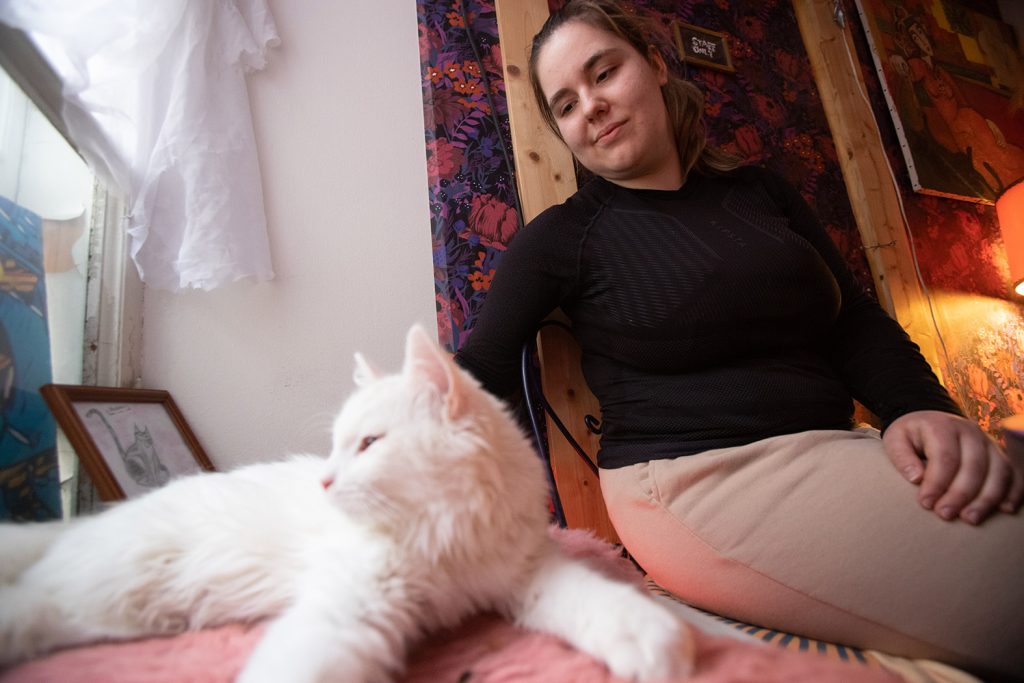In English: Visiiri met three Ukrainian exchange students – ”It’s complicated to say that we feel completely welcome”
There are just under twenty Ukrainian students currently studying at Tampere University. They want to make their voices heard.
Original text: Maria Muilu
Pictures: Eelis Berglund
Translation: Emma Brown
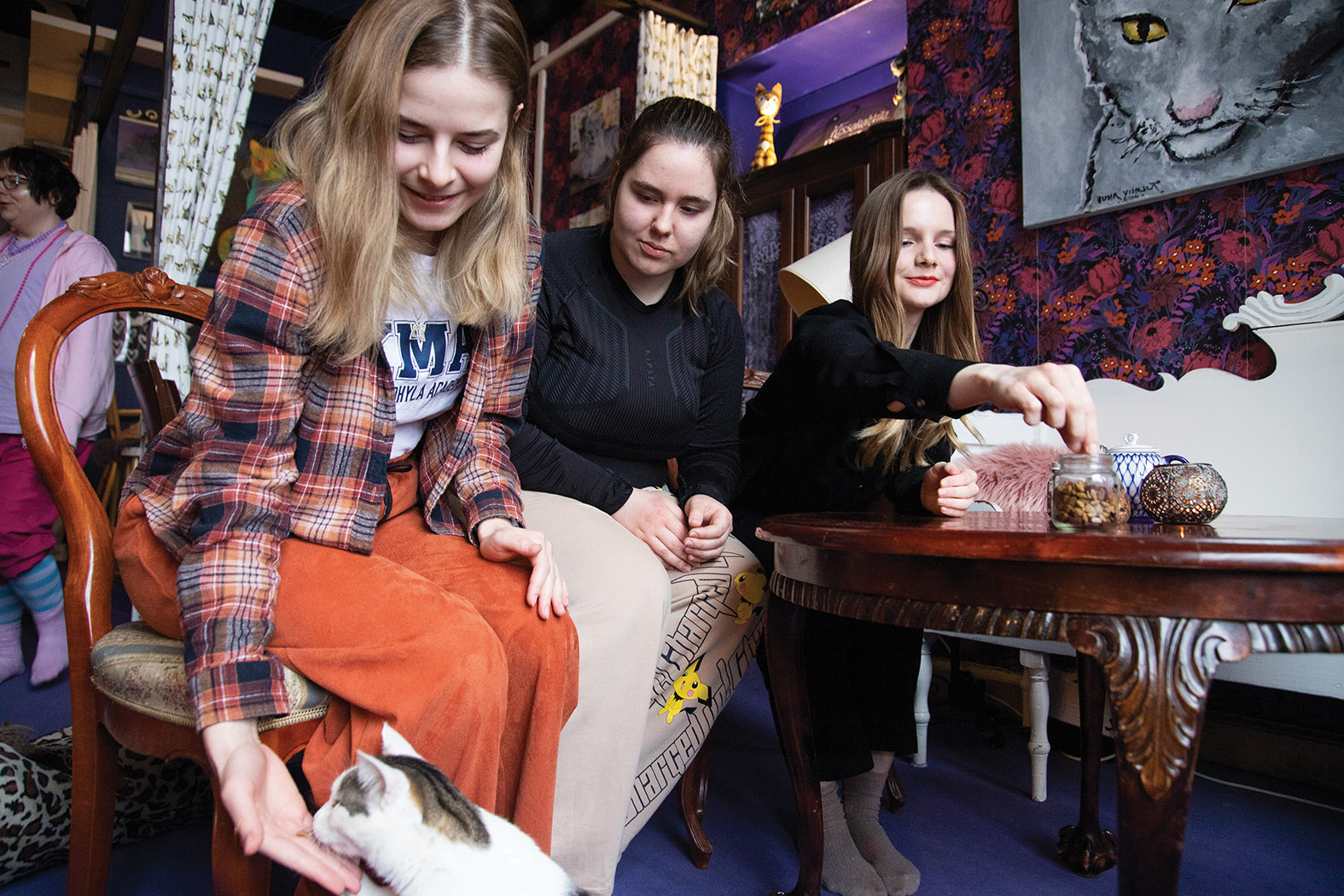
Artikkeli luettavissa Suomeksi Visiirin näköislehdessä.
Cats are larger in Finland than in Ukraine.
As Maryna Shahova says this, I wonder whether Finnish cats truly are larger than their Ukrainian fellows. What causes the difference?
Upon closer inspection, we realize that Hugo from the cat café must just be a particularly hefty individual. Maybe cats are usually the same size.
Maryna Shahova, Kateryna Steshenko, and Mariia Mykhailenko are Ukrainian exchange students at Tampere University. We decided to meet at a cat café, because all three are dedicated cat people. Shahova and Mykhailenko high-five and say they don’t really even like dogs. Except huskies. And corgis. And pugs.
Mykhailenko was the first to come to Finland. She arrived during the autumn semester, Steshenko and Shahova followed at the beginning of the year. They weren’t familiar with each other, even though they come from the same university. Shahova is studying social work, Steshenko computer sciences, and Mykhailenko sociology. Their home university in Ukraine is the National University of Kyiv-Mohyla Academy (KMA). The campus looks fancy in photos, with pillars along the façade.
Here in Finland, all three live in Hervanta. Shahova thinks Hervanta is a bit strange place to live. Is it a separate village or part of Tampere?
The amount of nature in Hervanta took Mykhailenko by surprise.
“My mother asked if I was living in a forest. I told her that’s just Tampere”, Mykhailenko says.
In addition to KMA, Tampere University has two Erasmus partner universities, both in Kyiv. The weather there is quite similar to Tampere around this time of the year. Wet snow and a couple of degrees below zero. Stores and cafés are open. Air-raid warnings howl through the air on most days.
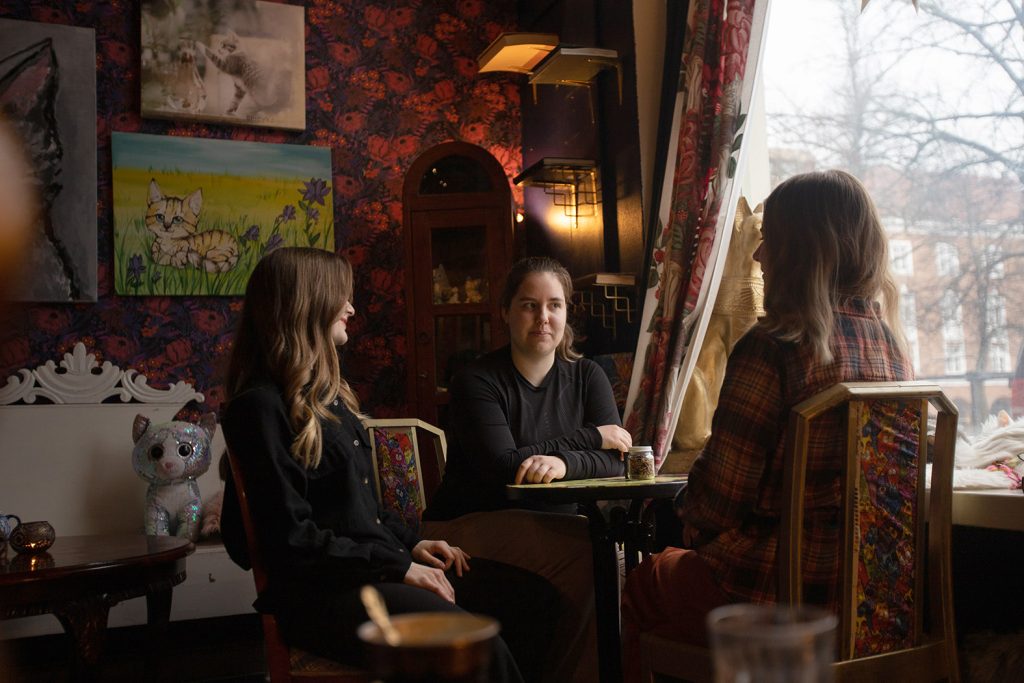
IN MID-FEBRUARY, there are 16 Ukrainian exchange students enrolled at Tampere University. There are also less than five Ukrainian degree students and six doctoral students.
Additionally, all Finnish universities have granted a special right to study to students who have left Ukraine. For example, one can complete studies in open university for free. In February, Tampere University had 23 students completing studies that don’t lead to a degree.
The numbers are small. They’re significantly larger, when looking at people who have fled Ukraine and been granted temporary protection in Finland.
According to the Finnish Immigration Service, by mid-February, there were over 49 000 applications for temporary protection from Ukrainian citizens. The Ministry of the Interior estimates that, in 2023, around 30 000–40 000 Ukrainians could come to Finland to seek international protection.
“The situation isn’t quite the same in higher education”, says Joanna Kumpula, Head of the International Education and Integration Support Unit at Tampere University.
The number of Ukrainian students fluctuates.
“In some situations, students have returned home sooner, because there have been times in the war during which it has felt like it could be easier to live at home.”
Mykhailenko felt guilty during her first semester in Finland.
“I was safe, nothing could happen to me here. I left my family and friends, who are in dangerous conditions. I thought: How can I continue my studies, how can I go to parties, how can I be happy, when the situation is how it is in Ukraine.”
For the first few months she felt frozen.
“I didn’t know if I was allowed to be happy.”
The others agree. Shahova says that she sometimes feels more fearful in Finland than at home in Ukraine. In her home country, she completed a first-aid course, and the capacity to help brought her some peace of mind.
“In Ukraine, I know I can help people like my friends or my neighbors if something happens to them. Here, I can’t help them.”
In the spring semester, the feelings of guilt have dissipated a little and made room for focusing on one’s own life.
“My own university and my exchange university have given me this opportunity to gain experiences, make new friends, and spread awareness on the situation in Ukraine”, Mykhailenko says.
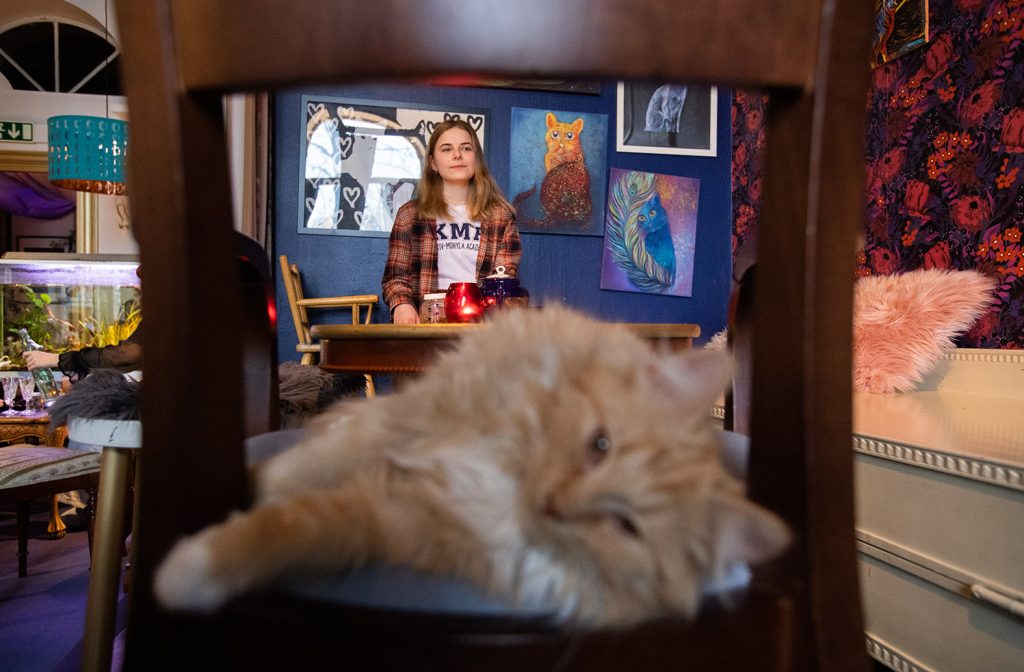
LAST SPRING, Joanna Kumpula had a person on her team who investigated what kind of services might be needed to support the Ukrainian students. After Russia’s attack, the first Ukrainian students came to Tampere around easter.
No one on the team speaks Ukrainian. There is one Russian speaker. The students know the contact information of the support persons.
As a community, the students have been welcomed, Kumpula says. The students have given feedback on how they’ve been taken into consideration well and they’ve enjoyed themselves. In building support, the university has done its best to consider varying needs.
“We haven’t built a large machinery, because there aren’t many of them.”
The City of Tampere formed a Ukrainian-language crisis support office. It was an important channel for the students already in Finland to navigate their feelings once the war began.
All EU countries have vowed to grant temporary protection for a year for everyone coming from Ukraine. The protection is now automatically extended for another year.
At the cat café, the exchange students are especially thankful for tutoring, comfortable student housing, and the friendliness of the other students at Tampere University.
But Shahova is clearly disappointed in the University for not offering space to hold an exhibition in support of Ukraine.
“It’s complicated to say that we feel totally welcome.”
Anna-Maria Maunu, the Communications Director at Tampere University, says that the reasons behind declining the exhibition were practical. The request for an exhibition space came late, and the planned dates would have been during break week. The organisers found a space for the exhibition at Tullintori.
Shahova messages me a couple of weeks after the interview. The university has agreed to help organise the exhibition. It will be held on the City Centre Campus, Päätalo buiding near Alakuppila -cafeteria from the 13th of March to the 4th of April.
Shahova and Steshenko have been participating in organising a project called Unissued Diplomas. As part of the project, there’s an exhibition featuring 36 diplomas of students whose studies were interrupted by the outbreak of the aggressive war.
They never completed their degree because they died in the war.
Some of them studied at the same university as Shahova, Mykhailenko, and Steshenko. The students who died were all younger than them, around 19–21 years old. Some were in the armed forces, some were volunteers, some civilians.
The exhibition features their photos, diplomas, and a brief summary of their life stories.
The proceeds from donations at the exhibit will go through KMA’s organisation to students and their families, who are living through the effects of the war.
The project’s objective is to raise awareness.
“The goal is to show how it feels for us. When I’ve told Finns that I’m from Ukraine, they’ve maybe gotten embarrassed when they don’t know what to say”, Steshenko says.
Shahova says that the weirdest part is realising some people don’t think about the war. It hurts.
“The project is for the students who have already died. People close to me have died.”
We have a small break; I fetch some napkins. The cats are napping.
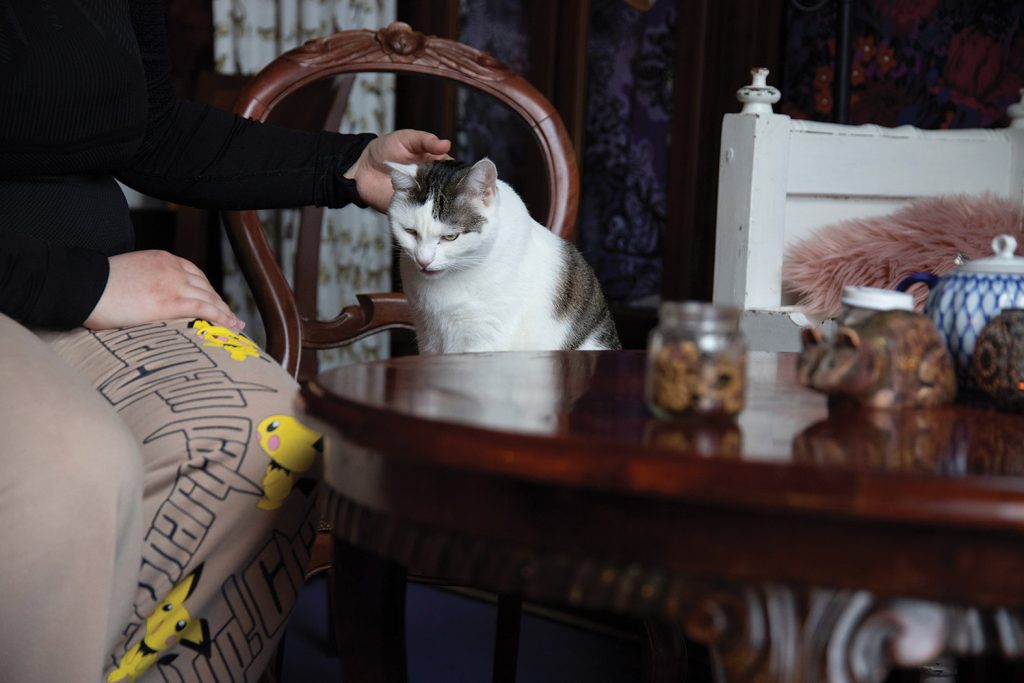
PEOPLE call cats with a similar sound in both Finnish and Ukrainian: kis kis. Shahova notes that sometimes, as she’s walking home late at night through Hervanta, old men also call her in the same way. Kis kis.
It doesn’t necessarily make her feel unsafe, since the old men roaming around Duo mall look weaker than her. But it is uncomfortable.
“It probably happens in every country.”
Their reaction to scary things has probably changed after the war began. When the trio was on a trip to Copenhagen, the fire alarm went off in the hostel.
“We didn’t hear it because we’re so used to alarms. What could happen to us here, a bombing?”, Mykhailenko laughs. Maybe there could be a bomb, but that’s doubtful.
The authorities ushered everyone out. Some ran outside in a panic and half-naked, the Ukrainians did not. They calmly packed their essentials and went outside.
They know what to do in case of a warning. Mykhailenko lists off the instructions from memory.
“Stay calm. Pack your important documents, laptop, and money in your bag and go outside. We’ve repeated it so many times. There might be three or four air-raid warnings a day in Kyiv.”
All three have an app on their phone that inform them of air-raid warnings in Ukraine. The app shows a long list of beginning and end times for past warnings.
On the day of the interview, there have been two air-raid warnings in Kyiv. It’s two o’clock in the afternoon.
Shahova forgot to delete the app when she came to Finland. The app’s alert sound is very loud.
“I was on the train when air-raid warnings began in Lviv. My phone began to howl, and the other passengers looked at me wondering what the heck was going on.”
Nowadays you can change the volume of the alert, Steshenko points out. When she was in Ukraine, she was mainly following the app’s alerts. After living so close to the warning tower, Steshenko doesn’t really even hear the air-raid alerts anymore.
Even though the alerts have become an everyday occurrence, the sounds of the war left their mark. Mykhailenko can’t sleep without headphones and melatonin anymore.
“I was in Kyiv and a nearby village was seized. For months, we heard bombings and other sounds of the war non-stop. Especially in February and March, the Russians kept attacking at night-time. I can’t sleep without headphones, because I hear everything.”
Shahova is used to sleeping in the midst of the sounds of bombing. She lived near Bucha and Irpin.
“I wasn’t fully aware of what was happening there. I thought that they’re far away, I can sleep safely. At times, the bombings are super loud.”
Some nights Shahova woke up to really raucous explosions. She asked her mother what happened. Mom answered: nothing.
“I realised the noises were just in my head. That lasted for maybe a month.”
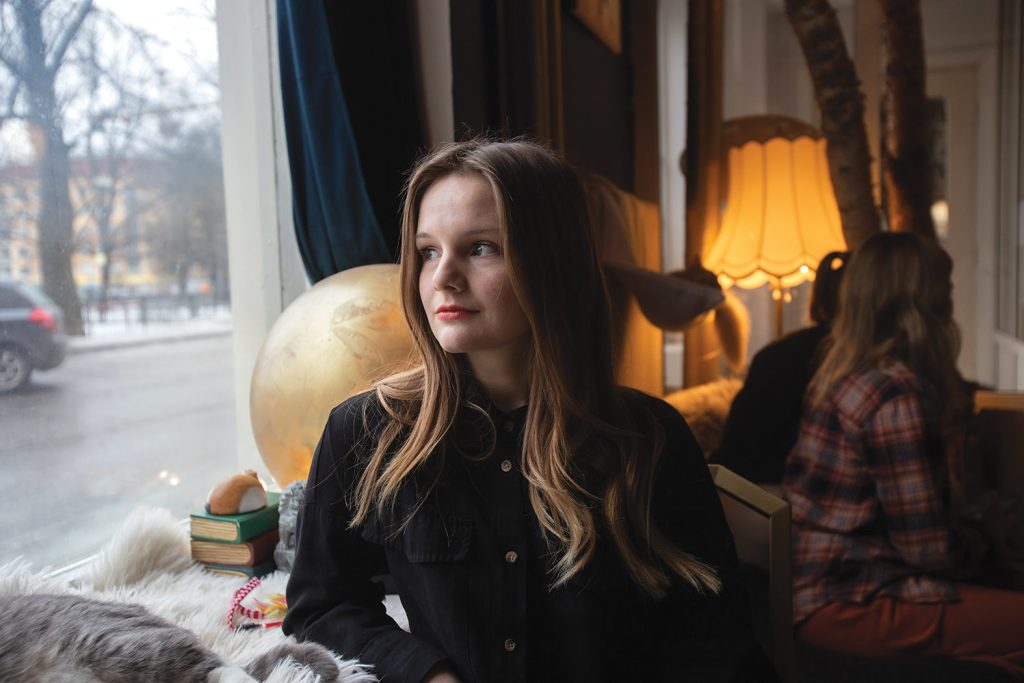
THE OTHER students have mainly been friendly – although Finns can, at times, be inconsiderate and ignorant. Once, when Mykhailenko was at a nightclub in Tampere, someone came to ask her if the war in Ukraine was already over. Since Mykhailenko is Ukrainian and is now dancing at a club looking happy – surely the person had just missed the good news!
“I thought, you can’t be serious. Do you expect me to be crying 24/7 or something?”, Mykhailenko says.
The others agree. Being in a constant state of shock is exhausting. Sometimes you just have to live.
The war has become normal in the media, too, ponders Shahova. New and shocking things are exciting to people. If you hear about death tolls on the news every day, they can end up just becoming numbers.
It warms Mykhailenko’s heart to see that someone is clearly well-informed about the situation in Ukraine. It’s important to her that people are interested in Ukraine and are following the news.
“The war isn’t some tedious TV show that you can turn off when you get bored.”
Tampere University’s cooperation with Russian and Belarusian organisations and institutions has been frozen. Joanna Kumpula thinks that cooperation will remain frozen for some time even after the war has ended.
Freezing means that there is no longer any kind of mobility in terms of students or staff between the countries.
“Of course we have Russian students, but they are degree students. They have received their right to study in Finland based on their own merits, and will continue their studies as before”, Kumpula says.
New individuals can still apply to all Finnish institutions of higher education. EU has, however, implemented sanctions, and sanction lists are checked for every new student.
Russia’s war of aggression has lasted for over a year. Even though the war is still ongoing, in the world of education there are already talks of the reconstruction phase. Finland has promised to help with rebuilding Ukraine’s education system. All eyes are already on planning on how we can collaborate in the reconstruction after the war is over.
Hundreds of school buildings have been completely destroyed. One concrete measure taken at Tampere University has been the creation of an education module for architecture students, which especially focuses on rebuilding.
“There is a strong desire to help and support.”
According to Kumpula, Tampere University has already had discussions with Ukrainian partner universities. All conversations have strongly centred around continuing collaboration and how, with it, we can best support the Ukrainian university community.
An important message from partner universities has ben preventing brain drain. The fear is that Ukrainian students, who have left the country during the war, will stay abroad and Ukraine is left without competence.
“The most important thing is to find ways to support finishing a Ukrainian degree that was disrupted by the war”, Kumpula says.
Steshenko, Shahova, and Mykhailenko will return to Ukraine in the beginning of summer. Their studies will resume right away since there are three semesters in their home university. They have a lot of courses and projects coming up. Shahova would like to go on exchange again at some point but doesn’t yet know where to. Steshenko has lots of coursework and a practical internship ahead of her this summer.
Mykhailenko gets to go home to her cat. The cat’s name is Masya, little.
“Her purring and soft fur help relieve stress and to forget all my worries for at least a moment. Masya is currently living with my family in Kyiv. She’s in good hands, so I’m not worried.”
